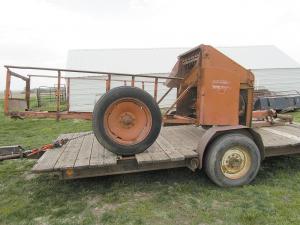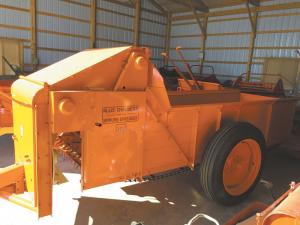2018 - Volume #42, Issue #3, Page #40
[ Sample Stories From This Issue | List of All Stories In This Issue | Print this story
| Read this issue]
Manure Spreader Collection Steadily Grows Bigger
 |
 |
Schoenfish had a couple of restored tractors he would take to a local antique tractor show. He and Beran decided to restore a spreader to go with one of them that matched the featured brand the coming year.
“When we decided to restore a second spreader the following year, that’s when the disease kicked in,” jokes Schoenfish. “One of our goals became having a spreader from each major equipment line. We’re still looking for a Co-op brand spreader and a Blackhawk.”
His list of brands are a who’s who of farm equipment, from full lines like Cockshutt, IHC, John Deere, Allis Chalmers, Case, Massey Harris, Oliver and Minneapolis Moline. Short lines like New Idea, New Holland, Patz, Shuler, Schultz and Kelly Ryan are also well represented.
“There are so many short lines; I know we will never get them all,” says Schoenfish.
There is some duplication (8 IHC No. 100’s). However, most are singles, including a MM LS300 that belonged to Randy’s wife’s parents and a John Deere L that belonged to Randy’s parents. Some are rubber-tired, while others are steel wheeled. They include 2 and 4-wheel models.
Some are more unusual than others, like the IH 103 with a long drive belt to power it or the AC 110 and Galloway spreaders with their front unloading action.
“The front unloading spreaders were pretty heavy on the front end, so that probably provided traction for the tractor,” says Schoenfish. “They have a hood to protect the driver. Inside the hood are propellers that appear to throw the manure out to either side. The mechanisms are similar to old end gate feeders. I would love to hear from readers who are familiar with them.”
Prices paid vary as well, based on the shape the spreader was in plus its rarity. About 2/3 of his spreaders cost less than $500, with many in the $150 or less group. Schoenfish has paid as little as $20 for a 4-wheel, New Idea 10A in poor shape. His top price was $3,000 for a Ferguson No. A-JO-20 that was already fully restored.
“That seems like a lot of money until you figure the cost of new tires, labor and materials that go into a manure spreader restoration,” says Schoenfish. “Not many people collect manure spreaders because they can get so rusty and worn out. Sometimes all you get is a frame. Then you find a manual and start buying lumber.”
Schoenfish notes that parts are often hard to find, and they have to rely on a machine shop to make a missing piece. One shop in a local Hutterite community often makes up decals for his spreaders as well.
“So many brands have merged or changed. You can’t get a decal, so I’ll find a picture of one and draw it out, figure out the colors and the print shop will make it for me,” says Schoenfish.
A CPA by trade, Schoenfish relies on Beran and a cousin, Glen Ziegler, to do much of the restorations.
Contact: FARM SHOW Followup, Randy and Loretta Schoenfish, 42472 Maxwell Rd., Scotland, S. Dak. 57059 (ph 605 583-4637 or 605 660-5129; rlakksho@gwtc.net).

Click here to download page story appeared in.

Click here to read entire issue
To read the rest of this story, download this issue below or click here to register with your account number.




